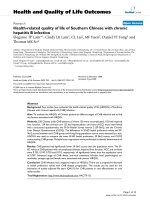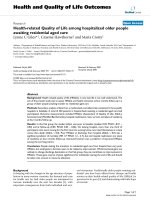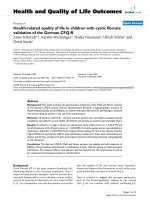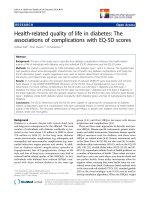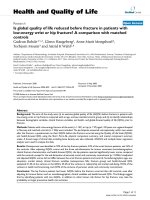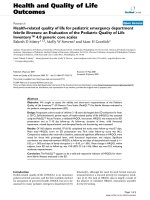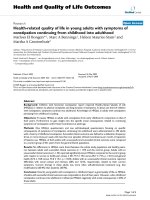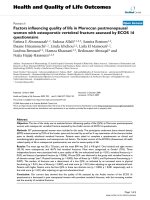báo cáo hóa học:" Measuring health-related quality of life in children with cancer living in mainland China: feasibility, reliability and validity of the Chinese mandarin version of PedsQL 4.0 Generic Core Scales and 3.0 Cancer Module" pdf
Bạn đang xem bản rút gọn của tài liệu. Xem và tải ngay bản đầy đủ của tài liệu tại đây (253.38 KB, 42 trang )
This Provisional PDF corresponds to the article as it appeared upon acceptance. Fully formatted
PDF and full text (HTML) versions will be made available soon.
Measuring health-related quality of life in children with cancer living in mainland
China: feasibility, reliability and validity of the Chinese mandarin version of
PedsQL 4.0 Generic Core Scales and 3.0 Cancer Module
Health and Quality of Life Outcomes 2011, 9:103 doi:10.1186/1477-7525-9-103
Yi Ji ()
Siyuan Chen ()
Kai Li ()
Nong Xiao ()
Xue Yang ()
Shan Zheng ()
Xianmin Xiao ()
ISSN 1477-7525
Article type Research
Submission date 30 August 2011
Acceptance date 23 November 2011
Publication date 23 November 2011
Article URL />This peer-reviewed article was published immediately upon acceptance. It can be downloaded,
printed and distributed freely for any purposes (see copyright notice below).
Articles in HQLO are listed in PubMed and archived at PubMed Central.
For information about publishing your research in HQLO or any BioMed Central journal, go to
/>For information about other BioMed Central publications go to
/>Health and Quality of Life
Outcomes
© 2011 Ji et al. ; licensee BioMed Central Ltd.
This is an open access article distributed under the terms of the Creative Commons Attribution License ( />which permits unrestricted use, distribution, and reproduction in any medium, provided the original work is properly cited.
Measuring health-related quality of life in children with cancer living in mainland China:
feasibility, reliability and validity of the Chinese mandarin version of PedsQL 4.0 Generic
Core Scales and 3.0 Cancer Module
Yi Ji
1
, Siyuan Chen
2
, Kai Li
1
, Nong Xiao
3
, Xue Yang
3
, Shan Zheng
1
, Xianmin Xiao
1*
1
Department of Pediatric Surgery, Children’s Hospital of Fudan University, Shanghai, 201102,
China
2
Department of Pediatric Healthcare, Children’s Hospital of Fudan University, Shanghai, 201102,
China
3
Department of rehabilitation center, Children’s Hospital of Chongqing Medical University,
Chongqing, 400014, China
Email addresses:
YJ: ; SYC: ;
KL: ; NX: ;
XY: ; SZ: ;
XMX:
*Correspondent author: Xianmin Xiao, M.D., PhD. Department of Pediatric Surgery, Children’s
Hospital of Fudan University. 399 Wanyuan Road, 201102, Shanghai, China. Tel.: +86 21
64931212; Fax: +86 21 64931211; Email address:
Abstract
Background: The Pediatric Quality of Life Inventory (PedsQL) is widely used instrument to
measure pediatric health-related quality of life (HRQOL) for children aged 2 to 18 years. The
purpose of the current study was to investigate the feasibility, reliability and validity of the
Chinese mandarin version of the PedsQL 4.0 Generic Core Scales and 3.0 Cancer Module in a
group of Chinese children with cancer.
Methods: The PedsQL 4.0 Genetic Core Scales and the PedsQL 3.0 Cancer Module were
administered to children with cancer (aged 5-18 years) and parents of such children (aged 2-18
years). For comparison, a survey on a demographically group-matched sample of the general
population with children (aged 5-18) and parents of children (aged 2-18 years) was conducted
with the PedsQL 4.0 Genetic Core Scales.
Result: The minimal mean percentage of missing item responses (except the School Functioning
scale) supported the feasibility of the PedsQL 4.0 Generic Core Scales and 3.0 Cancer Module for
Chinese children with cancer. Most of the scales showed satisfactory reliability with Cronbach’s α
of exceeding 0.70, and all scales demonstrated sufficient test-retest reliability. Assessing the
clinical validity of the questionnaires, statistically significant difference was found between
healthy children and children with cancer, and between children on-treatment versus off-treatment
≥12 months. Positive significant correlations were observed between the scores of the PedsQL 4.0
Generic Core Scale and the PedsQL 3.0 Cancer Module. Exploratory factor analysis demonstrated
sufficient factorial validity. Moderate to good agreement was found between child self- and parent
proxy-reports.
Conclusion: The findings support the feasibility, reliability and validity of the Chinese Mandarin
version of PedsQL 4.0 Generic Core Scales and 3.0 Cancer Module in children with cancer living
in mainland China.
Background
Currently, an increasing number of children with cancer are cured for their diseases in the world,
including China. However, common treatments such as surgery, radiotherapy, chemotherapy,
whether palliative or curative, can have deleterious side-effects affecting many aspect of the
quality of children’s lives — not only physical aspects but also social and emotional aspects [1, 2].
Survivors may experience a number of long-term adverse effects from the tumor and its treatment
[3-6]. Focusing on the patients’ psychosocial and social well-being in addition to their physical
health is an essential requirement in accordance with the WHO definition of health and well-being
[7].
Health-related quality of life (HRQOL) is a continuous concept influenced by a person’s
objective assessments of function or health status as well as subjective perceptions of their
personal health [8]. It is increasingly acknowledged as an important health outcome measure in
clinical trials and health services research and evaluation. However, one challenge in measuring
HRQOL in children is that the instrument must account for the continuous physical, emotional,
social and cognitive development during childhood and adolescence. Another problem is the
questionnaires should provide the required information [9]. Although there are a number of
generic HRQOL instruments applicable to children, assessment has relied exclusively on
proxy-report [10], or the concordance between self- and proxy-report has been demonstrated to be
imperfect [11]. Given the multidimensional impact cancer has on children, it is necessary to find
an appropriate instrument to capture and evaluate the HRQOL of these children.
The Pediatric Quality of Life Inventory (PedsQL) is one of the more promising HRQOL
measures for children aged 2-18 years [12, 13]. The advantages of PedsQL included brevity,
availability of age-appropriate version, and parallel for child and parent. The approach is modular,
with Generic Core Scales complemented by disease-specific modules, such as the PedsQL Cancer
Module [14-19]. The PedsQL 4.0 Generic Core Scales was specifically designed for application in
both healthy and patient populations. The PedsQL 3.0 Cancer Module was designed to measure
HRQOL dimensions specific to pediatric cancers. Studies with PedsQL indicate that both healthy
children and children with cancer aged 5-18 years can self-report their HRQOL [20-22].
As the population of Chinese children nears 300 million, a conservative projection of 45
thousands new cases of pediatric cancer each year can be made [23]. However, limited
information is available to understand the HRQOL of children with cancer living in mainland
China. The objective of this study was to investigate the feasibility, reliability, and validity of the
Chinese mandarin version of the PedsQL 4.0 Generic Core Scales and 3.0 Cancer Module in
children with cancer.
Method
Participants and Settings
This study was developed in the cities of Shanghai and Chongqing, China. We recruited
children with cancer and their parents by means of convenience samples from 2 children’s
hospitals at the cities. Children aged 5 to 18 years who were diagnosed with cancer were included
in this study, and the parents were included if their child was 2 to 18 years old. Children were
excluded from this study if they had comorbid disease or major developmental disorders. The
sample size needed to procedure medium correlation (0.30) in the examination of discriminant
validity was calculated. 154 subjects were needed to take part in the study when we set the type
Ⅰerror at 1% and the statistical power at 90%. We estimated that approximately more than
60-70% of participants would agree to participate. Finally, two hundred and seventy five families
were approached for the study. Controls were 300 families of healthy children aged 2 to 18 years
recruited from schools, with distributional matching to the patients on age and gender.
Measurement
PedsQL 4.0 Generic Core Scales
The 23-item PedsQL 4.0 Generic Core Scales encompasses the essential core domains for
pediatric HRQOL measurement: (1) physical functioning (8 items), (2) emotional functioning (5
items), (3) social functioning (5 items), and (4) school functioning (5 items). It comprises of
parallel child self-report and parent proxy-report format. Child self-report includes ages 5-7
(young children), 8-12 (children), and 13-18 (teens) years. Patent proxy-report includes ages 2-4
(toddlers), 5-7, 8-12, and 13-18 years. The items for each of the forms are essentially identical,
differing in developmentally appropriate language, or first or third person tense. The instructions
ask how much of a problem each item has been during the past one month. A 5-point response
scale is utilized across child self-report for ages 8-18 and parent proxy-report (0 = never a problem;
1 = almost never a problem; 2 = sometimes a problem; 3 = often a problem; 4 = almost always a
problem). The child-report for children aged 5-7 is completed with the help of an interviewer. To
increase its ease of use, the rating scale has been reworded and simplified to a 3-point scale (0 =
not at all a problem; 2 = sometimes a problem; 4 = a lot of a problem), with each response choice
anchored to a happy to sad faces scale. Items are reverse-scored and linearly transformed to a
0-100 scale, with higher scores indicating a better HRQOL. Scale scores are computed as the sum
of the items divided by the number of items answered. If more than 50% of the items in the scale
are missing, the scale score is not computed. To create the Psychosocial Functioning score, the
mean is computed as the sum of the items divided by the number of the items answered in the
Emotional, Social, and School Functioning Scale.
PedsQL 3.0 Cancer Module
The PedsQL 3.0 Cancer Module instrument encompasses 8 subscales: (1) pain and hurt (2
items), (2) nausea (5 items), (3) procedural anxiety (3 items), (4) treatment anxiety (3 items), (5)
worry (3 items), (6) cognitive problems (5 items), (7) perceived physical appearance (3 items),
and (8) communication (3 items). The cognitive problems scales were modified to include fewer
items for children aged 2-7 years. The format, instructions, Likert response scale, and scoring
method of the Cancer Module are identical to the PedsQL 4.0 Generic Core Scales [24].
Procedure
The investigation was performed by 4 research students majoring in Pediatrics and 2 nurses. All
of them were trained in interviewing and administering questionnaires. On-treatment status was
defined as patients who were receiving medical treatment to induce remission. Off-treatment
status was defined as patients who completed all therapy by the time of the assessment [25, 26].
The on-treatment patient was interviewed while hospitalized. The off-treatment patient was
interviewed during clinic visits. Parents were interviewed first, and were asked whether they
would allow their children to participate in the study. The parents and their children completed the
questionnaire independently during the pediatric patients’ hospitalization or outpatient department
visit. All the parents were asked to fill out the PedsQL 4.0 Generic Core Scales and the Cancer
Module. The children were required to complete the questionnaires by self-administration except
the Young Children by interview-administration [19]. The interviewers were available to assist the
completion of the questionnaires if the parents/children had questions on semantic or conceptual
understanding. They were also responsible for collecting and checking the questionnaires to
ensure that there were no missing data or logical mistakes. Test-retest reliability was assessed at
Children’s Hospital of Fudan University (the same hospital in Shanghai). Thirty-four families with
patients in stable condition according to their physician completed the PedsQL measures a second
time (with an interval of 1-3 weeks between applications). For control group, the questionnaires
interviews were conducted at schools. Written information was sent to parents who completed
questionnaires at home, returning them to school by a specified date.
Cross-culture adaptation and Ethical considerations
The Chinese Mandarin Version was provided by MAPI Research Trust that translated the
version according to their standardized procedures. Briefly, the instruments were translated
independently into Chinese by two professional translators (native Chinese speakers) and
translated back into English by two English native speakers (bilingual in Chinese). Then, a
comparison between the backward version and the original version was assessed in order to detect
any misunderstandings or mistranslations in the intermediary forward version of the
questionnaires [27, 28]. 15 children with cancer participated in pilot testing along with their
parents. In consideration of the Chinese sociocultural environment, we avoided using the term
‘cancer’ or ‘tumor’ in questionnaires. The permission was obtained from its developer, James W.
Varni, PhD. The human subject institutional review boards at each hospital approved the study. All
subjects were given detailed written information about the methods, aims, and the voluntary
nature of participation in the study, and written parental informed consent and child assent were
obtained prior to enrollment.
Statistical analysis
Feasibility was determined from the average completion time and percentage of missing
response. The average completion time was defined as the mean of completion time of the Generic
Core Scales and Cancer Module. The percentage of all possible item-responses left unanswered
was calculated for each subject on each single and summary scale and averaged over subjects [29].
The presence of floor and ceiling effects was assessed for the subscales scores and summary
scores.
Scale internal consistency reliability was determined by calculating Cronbach’s coefficient
alpha. Scales with reliabilities of 0.70 or greater are recommended for comparing patients groups,
while a reliability criterion of 0.90 is recommended for analyzing individual patient scale scores
[30]. To determine retest reliability, the intra-class correlation coefficients (ICCs) between the
initial test and retest scores was examined, with an ICC value of 0.40 representing moderate, 0.60
good, and 0.80 high agreement [31].
Discriminant validity was determined using the known-groups method. The Generic Core
Scales scores were compared between groups differing in known health conditions (healthy
children and children with cancer). HRQOL scores of children from the general population and
children with cancer were compared using independent sample t test. To determine the magnitude
of the differences, effect sizes were evaluated. Effect size as utilized in these analyses was
calculated by taking the difference between the healthy sample mean and the oncology sample
mean, divided by the pooled standard deviation [32]. Additionally, analyses of variance also were
conducted to examine whether there were differences in Generic Core Scales and Cancer Module
scores among children with cancer on treatment and off-treatment (≤ 12 months or > 12 months).
We hypothesized that healthy children would have higher PedsQL 4.0 scores (better HRQOL)
than children with cancer. Moreover, we hypothesized that children with cancer on-treatment
would report significant differences in HRQOL compared with those of children with cancer
off-treatment based on previous studies [19, 33, 34].
Construct validity for the Cancer Module was examined through an analysis between the
Cancer Module Scales scores and relevant Generic Core Scales scores. It had been reported that
computing the intercorrelations among scales provides initial information on the construct validity
of an instrument. We hypothesized greater disease-specific symptoms or problems would correlate
with lower overall generic HRQOL based on the conceptualization of disease-specific symptoms
as causal indicators of generic HRQOL [35]. Correlation effect sizes were designed as small
(0.01-0.29), medium (0.30-0.49), and large (≥ 0.50). Pearson coefficients were utilized in these
analyses.
Exploratory factor analysis was performed on the items to test the PedsQL underlying
dimensions [36]. Principal component analysis with oblique rotation was performed to extract the
factors. Factors with an eigenvalue less than 1.0 were disregarded.
Parent/child intercorrelations were computed to examine cross-informant variance [37].
Correlation effect sizes are designated as small (0.01-0.29), medium (0.30-0.49), and large (≥
0.50).
Statistical analyses of the study were conducted by SPSS 16.0 for Window (SPSS, Inc, Chicago,
USA) and the significance level was set at 0.05.
Results
Sample characteristics
Of the patients group, 7 families refused to participate due to non-compliance, 2 children were
later found to be ineligible and excluded from analysis, leaving 266 eligible families. The patients
group was comprised of 202 children aged 5-18 years and 266 parents of children aged 2-18 years.
The mean age of the 154 boys (57.9%) and 112 girls (42.1%) was 8.8 years (SD = 3.8). One
hundred sixty-three patients (61.3%) had been diagnosed with hematological diseases, and the
remaining patients (38.7%) had solid tumors. The mother answered the questionnaires in 82.7% of
the cases and the father in 17.3% of the cases. 109 (41.0%) patients completed all therapy by the
time of assessment (n = 109), and 74 (27.8%) patients had been off treatment for over 12 months
(n = 74). Of the control group, 284 families returned the questionnaires, which gave a response
rate of 94.7%. The mean age of the 159 boys (56.0%) and 125 girls (44.0%) was 9.1 years (SD =
3.9). Self-report forms are completed by 216 children (Table 1). There was no statistically
significant difference between patients and healthy children refer to age and gender.
Descriptive statistics
As showed in Table 2, the Generic Core scores were consistently higher for child reports than
for parent reports. No floor effects were seen in the patient group. We found ceiling effects both in
child self- and parent proxy-reports ranging from 2.6% to 19.8% in the patient group and 5.6 to
39.8% in the control group, with highest values in the Social Functioning Scale for child self- and
parent proxy-reports from the patient and comparison samples. We also observed greater ceiling
(18.0-40.6%) than floor effects (0.8-5.6%) in the Cancer Module, with a notable ceiling effect in
the Pain and hurt scale and a moderate one in other scales for child self- and parent proxy-reports
(Table 3).
Feasibility
The majority of patients and their parents needed only 10-18 and 6-10 minutes to complete the
two questionnaires, respectively. For child self- and parent proxy-report on the PedsQL 4.0
Generic Core Scales, the percentage of missing item responses was 0.6% and 0.4%, respectively,
for all scales except the School Functioning Scale. The percentage of missing items for the School
Functioning scale was 21.5% for child self-report (aged 5-18 years) and 46.3% for parent
proxy-report (aged 2-18 years). This large percentage missing items for the School Functioning
scale may exist because many Chinese children younger than 7 years neither attend kindergarten
nor school. For child self- and parent proxy-report on the PedsQL 3.0 Cancer Module, the
percentage of missing item responses was 0.9% and 1.3%, respectively, for all scales. On this
module, 40.7% of the items across all forms had no missing responses. The highest percentage of
missing responses for any single item on the Caner Module was 3.2% for Child self-report in the
Communication Ⅰscale (it is had for me to ask the doctors and nurses questions) and 5.9% for
parent proxy-report in the WorryⅠscale (worry about side effect from medical treatment).
Internal consistency and test-retest reliability
Internal consistency reliability coefficients are presented in Table 4. Cronbach’s alpha for Total
Scale of the Generic Scales and the Caner Scale were all above 0.7 in both self- and proxy-reports.
Most scales exceeded the minimum reliability standard of 0.70, and a number of scales
approached or met the reliability criterion of 0.90 recommended for analyzing individual patient
scores.
Retests for reliability were completed by 27 children with cancer (aged 5-18 years) and 34
patents of such children (aged 2-18 years) who completed the initial questionnaires. ICCs for
test-retest reliability for child self- and parent proxy-report are presented in Table 4. All of these
ICCs are in the good to excellent reliability range.
Validity
Table 2 demonstrates the differences between healthy children and children with cancer. For
each Generic Core Scale, children with cancer and their parents report statistically significant
lower HRQOL than healthy children. Table 5 provides the result comparing the three groups of
patients in known distinct clinical conditions (on-treatment, off treatment ≤ 12 months and
off-treatment > 12 months) for child self- and parent proxy-report on the PedsQL Generic Core
Scales and Cancer Module. For both child self- and parent proxy-report, the PedsQL 4.0 Generic
Core Scale Total Score, Physical Functioning, and Emotional Functioning scores demonstrated
significant differences between the patients on-treatment and off-treatment > 12 months. For the
PedsQL 3.0 Caner Module Scales, children who had been off-treatment over 12 months and their
parents demonstrated significant higher scores than children who had been on-treatment on the
Pain and hurt, Nausea, and Procedural Anxiety subscales. In addition, the scores of parent
proxy-report Treatment Anxiety and Worry subscale were significant differences between children
on-treatment versus off-treatment > 12 months.
The result of the factor analysis for child self- and parent proxy-report of the Generic Core
Scales and Cancer Module are presented in Table 6 and 7. For the Generic Core Scales, an
eigenvalue cutoff of 1.0 resulted in a six factor solution for child self- and parent proxy-report,
accounting for 62.3% and 69.6% of the variance, respectively. For the Cancer Module, an eight
factor solution for child self-report was result, accounting for 78.0% of the variance; and a
seven-factor solution for parent proxy-report was result, accounting for 86.6% of the variance.
As to the intercorrelations among the various Generic Core Scales and the Cancer Module
scales estimated using correlation coefficients. As anticipated, correlation coefficients between the
Generic Core Scale Total Scale and the Cancer Module subscales were of medium to large effect
size for both the child self- and parent proxy-reports (Table 8).
Table 8 presents the correlation between scores of the child self- and parent proxy-reports of the
Genetic Core Scales and the Caner Module. A positive correlation between child self- and parent
proxy-reports was found on all scales of both the Generic Core Scales and the Cancer Module.
Discussion
This study demonstrated the feasibility, reliability, and validity of the Chinese mandarin version
of PedsQL 4.0 Generic Core Scales and 3.0 Cancer Module in children with cancer living in
mainland China.
With regard to obtention of result, only a short amount of time was required to complete the
questionnaires. This short completion time made these two instruments particularly applicable to
the fast-pace setting of an outpatient clinic. Additionally, the overall percentage of missing item
responses across the PedsQL scales was low, indicating that children and their parents were able to
provide good data regarding the child’s HRQOL. However, our results showed that there were
several items, i.e. ‘worry about side effect from medical treatment’ and ‘it is had for me to ask the
doctors and nurses questions’, had a high missing rate. We found that the percentage of missing
values was primarily from the 2-7 years old children. The reason may be that some parents
regarded their children as too young to understand the questions, or some children aged 5-7 years
had difficult to understand these questions, since not all of them attend kindergarten or school.
This finding is comparable with previous reports of the PedsQL Cancer Module [9], and also in
yline with other PedsQL disease-specific modules [38]. This indicated that some modifications for
the items of these subscales in Toddler and Young Child version scale were necessary.
No (for Generic Core Scales) or minimal (for the Cancer Module) floor effects and more
accentuated ceiling effects for both scales means that distinction by Chinese mandarin version of
the PedsQL 4.0 Generic Core Scale and 3.0 Cancer Module between children who do extremely
well or just well is less than excellent [39]. On the other hand, this finding support the opinion that
the PedsQL scaling range is acceptable for use in patients experiencing greater health-related
problems, which is the area of most concern in research with severe or chronic illness [40, 41].
For internal consistency, both the PedsQL 4.0 Generic Core Scales and 3.0 Cancer Module
reliabilities approached or exceeded the alpha coefficient standard of 0.7 for most scales. The
PedsQL 4.0 Generic Core Scales Total Score for parent proxy-report exceeded an alpha of 0.90,
recommended for individual patient analysis, making the Total Scale score suitable as a summary
score for the primary analysis of HRQOL outcome in clinical trials and other group comparisons
[42]. The total score of the School Functioning, Pain and hurt, Perceived physical appearance, and
Communication subscales for child self-report did not approach or exceed 0.70. These findings are
consistent with reliability estimates seen in the original English version and the German Version [9,
19]. This low internal consistency may be related to the small number of items that compose the
subscales and the low level of schooling in the sample. Although Cronbach’s alpha represents the
lower bound of the reliability of a measurement instrument, and is a conservative estimate of
actual reliability [43], scale that did not meet the 0.70 standard should be used only for descriptive
analyses.
It is recommended that the interval between measurements must be long enough to reduce the
effects of memory and short enough to diminish the likelihood of systemic alterations. Previous
studies found that a period of 1 to 4 weeks is considered adequate [44, 45]. In this study, we used a
1-3 weeks interval. Meanwhile, patients were selected who were considered to be stable and were
not expected to change before completing the questionnaires for the second time. All scales for
both the child self- and parent proxy-reports showed good to excellent reliability, indicating that
the Chinese mandarin version of PedsQL 4.0 Generic Core Scale and Cancer Module are stable
over time.
As can be expected, the PedsQL 4.0 Generic Core Scales indicated better HRQOL in children of
the general population than in children with caner on all scales, which support the construct
validity of the translated instrument. Additionally, we found that in child self- and parent
proxy-report, physical health subscale scores and some psychosocial health subscale scores in
children off-treatment over 12 months were significantly higher than children on-treatment in the
two instruments. This result was similar to another study assessing HRQOL scores between
children on-treatment and those who were off-treatment [33]. Meanwhile, we found that many
psychosocial health subscale scores were not significant improved among children who had been
treatment over 12 months. This finding is also in line with studies of HRQOL in children with
cancer [19, 20, 33]. It would seem to reflect the long-term burden of psychosocial trials which
individuals face as they grow older: they may be afraid, often on an unconscious level, that the
disease will recur, they may experience a setback resulting from the stresses during treatment or
they can be confronted with new problems evolving from the illness or long-term side effects of
treatment [46]. We, like others, believe that psychosocial support remains important long after
treatment has completed, and even when the physical health appears well [21, 47].
The results of the factor analysis in general support the hypothesized factor structure of the
PedsQL. For the PedsQL 4.0 Generic Core Scales, all items split into two different factors. The
results do not resemble Varni’s five factor structure in the original PedSQL version [41]. In their
study, Emotional Functioning items in both child self- and parent reports do not split into two
different factors. But the findings of factor analysis may be sample-specific, other studies showed
different results too [27, 48], this is why the factor structure should be reinvestigated in clinical
samples. For the PedsQL Cancer Module, exploratory factor analysis identified 8 factors for child
self-reports, replicating those of the original theoretical dimensions. In parent proxy-reports, those
items of the Procedural anxiety and Treatment anxiety subscales of the original theoretical
dimension loaded on the same factor, reducing the number of factors to 7. In mainland China,
parents generally believe that the fear of injection, surgery or other invasive treatments is the main
reason why their children try to avoid going to the hospital [49], so that their worry about
treatment may linked to the ‘Procedural anxiety’ factor.
Consistent with the conceptualization of disease-specific symptoms as causal indicators of
generic HRQOL, the intercorrelations between the PedsQL 4.0 Generic Core Scales total score
and PedsQL 3.0 Cancer Module were in medium to large range, supporting construct validity.
Regarding the agreement between child self- and parent proxy-reports, our data showed moderate
to good agreement both for the Generic Core Scales and the Cancer Module. Finding higher
correlations for the observable parameters in general, like the Physical Functioning Scale in the
Generic Core Scale and Pain and hurt, Nausea, and Treatment anxiety in the Cancer Module. This
finding is consistent with that of previous studies [33, 38]. Although child self-reports is critical,
perspectives of parents also are important. In clinical practice, there may be circumstances when
the child is too young, or too ill too complete an instrument, and parent proxy-report may be
needed in such cases. Additionally, it is typically parents’ perceptions of their children’s HRQOL
and symptoms that influences health care utilization. Therefore, in cases in which pediatric
patients are not able to provide self-report, reliable and valid parent proxy-report instrument are
needed [50].
This study has several inherent limitations. One limitation of the study was that the study
sample was entirely composed of patients seeking medical evaluation or treatment for cancer and
cannot be considered representative of the general population of pediatric oncology patients. In
mainland China, many children with cancer have refused or abandoned treatment for financial
reasons, which is unknown in developed countries and regions [51]. Information about the
HRQOL in these patients is still unknown. Second, all the subjects in this study were recruited in
two of the largest cities (Shanghai and Chongqing) in China. The majority of our patients came
from urban areas instead of rural areas. In fact, more than half of China’s population now lives in
rural areas where only a few children under 14 years of age who have acute leukemia receive
protocol based therapy [23]. Therefore, further studies conducted in rural areas are suggested.
Third, information on participants’ socioeconomic status was not available. Questions still exist as
to whether socioeconomic status is associated with HRQOL in children with cancer in our society
[52].
On the other hand, the information from standardized questionnaires provided a wealth of
information about the physical and psychosocial status of children with cancer living in mainland
China. Moreover, we compared the patients with normal children matched for sex and age, and all
subjects were recruited from the same health care catchment areas and assessment were carried
out in closely related time periods in both groups. Therefore, the study of these children could
provide a more accurate picture of pediatric cancer patients referring to clinical practices, and
provide relevant clues for future interventions that promote care and support of children with
cancer.
Conclusion
In summary, our results generally support the feasibility, reliability and validity of the Chinese
mandarin version of PedsQL 4.0 Generic Core Scales and the Cancer Module. Further studies
should focus on testing responsiveness of the Chinese mandarin version scales in longitudinal
studies and in other areas, particularly in rural areas. Studies measuring HRQOL in children who
have refused or abandoned treatment are also warranted.
Competing interests
The authors declare that they have no competing interest.
Authors’ contributions
YJ contributed to the design of the study, the conception and interpretation of the statistical
analysis, and drafted the manuscript. SYC conducted the statistical analysis, contributed to the
interpretation of data, the drafting of the manuscript. KL, NX, XY contributed the acquisition of
data. SZ and XMX contributed to the conception and design of the study, and revised of the
manuscript. All authors read and approved the final manuscript.
Acknowledgements
This work was supported by the Department of Pediatric Surgery, Children’s Hospital of Fudan
University. Dr Varni holds the copyright for the PedsQL. No institution was involved in the
analysis of interpretation of data, in writing the article, or in the decision to submit the paper for
publication. The authors are indebted to all participating practitioners and doctors’ assistant for
their participation in the study. The authors are also indebted to all reviewers for their kindly
reviewing of the manuscript.
References
1. Collins JJ, Byrnes ME, Dunkel IJ, Lapin J, Nadel T, Thaler HT, Polyak T, Rapkin B,
Portenoy RK: The measurement of symptoms in children with cancer. J Pain Symptom
Manage 2000, 19(5):363-377.
2. Erickson JM, Beck SL, Christian BR, Dudley W, Hollen PJ, Albritton KA, Sennett M, Dillon
RL, Godder K: Fatigue, sleep-wake disturbances, and quality of life in adolescents receiving
chemotherapy. J Pediatr Hematol Oncol 2011, 33(1):e17-e25.
3. Weintraub N, Rot I, Shoshani N, Pe'Er J, Weintraub M: Participation in daily activities and
quality of life in survivors of retinoblastoma. Pediatr Blood Cancer 2011, 56(4):590-594.
4. Gurney JG, Tersak JM, Ness KK, Landier W, Matthay KK, Schmidt ML: Hearing loss,
quality of life, and academic problems in long-term neuroblastoma survivors: a report from
the Children's Oncology Group. Pediatrics 2007, 120(5):e1229-e1236.
5. Barr RD, Chalmers D, De Pauw S, Furlong W, Weitzman S, Feeny D: Health-related
quality of life in survivors of Wilms' tumor and advanced neuroblastoma: aA cross-sectional
study. J Clin Oncol 2000, 18(18):3280-3287.
6. Nathan PC, Ness KK, Greenberg ML, Hudson M, Wolden S, Davidoff A, Laverdiere C,
Mertens A, Whitton J, Robison LL et al: Health-related quality of life in adult survivors of
childhood Wilms tumor or neuroblastoma: A report from the childhood cancer survivor
study. Pediatr Blood Cancer 2007, 49(5):704-715.
7. Grad FP: The Preamble of the Constitution of the World Health Organization. Bull
World Health Organ 2002, 80(12):981-984.
8. Testa MA, Simonson DC: Assesment of quality-of-life outcomes. N Engl J Med 1996,
334(13):835-840.
9. Felder-Puig R, Frey E, Proksch K, Varni JW, Gadner H, Topf R: Validation of the German
version of the Pediatric Quality of Life Inventory (PedsQL) in childhood cancer patients off
treatment and children with epilepsy. Qual Life Res 2004, 13(1):223-234.
10. Matza LS, Swensen AR, Flood EM, Secnik K, Leidy NK: Assessment of health-related
quality of life in children: a review of conceptual, methodological, and regulatory issues.
Value Health 2004, 7(1):79-92.
11. Varni JW, Katz ER, Colegrove RJ, Dolgin M: Adjustment of children with newly
diagnosed cancer: cross-informant variance. J Psychosoc Oncol 1995, 13(3):23-38.
12. Varni JW, Seid M, Rode CA: The PedsQL: measurement model for the pediatric quality
of life inventory. Med Care 1999, 37(2):126-139.
13. Klaassen RJ, Krahn M, Gaboury I, Hughes J, Anderson R, Grundy P, Ali SK, Jardine L, Abla
O, Silva M et al: Evaluating the ability to detect change of health-related quality of life in
children with Hodgkin disease. Cancer 2010, 116(6):1608-1614.
14. Marino BS, Shera D, Wernovsky G, Tomlinson RS, Aguirre A, Gallagher M, Lee A, Cho CJ,
Stern W, Davis L et al: The development of the pediatric cardiac quality of life inventory: a
quality of life measure for children and adolescents with heart disease. Qual Life Res 2008,
17(4):613-626.
15. Palmer SN, Meeske KA, Katz ER, Burwinkle TM, Varni JW: The PedsQL Brain Tumor
Module: initial reliability and validity. Pediatr Blood Cancer 2007, 49(3):287-293.
16. Varni JW, Burwinkle TM, Berrin SJ, Sherman SA, Artavia K, Malcarne VL, Chambers HG:
The PedsQL in pediatric cerebral palsy: reliability, validity, and sensitivity of the Generic
Core Scales and Cerebral Palsy Module. Dev Med Child Neurol 2006, 48(6):442-449.
17. Varni JW, Burwinkle TM, Jacobs JR, Gottschalk M, Kaufman F, Jones KL: The PedsQL in
type 1 and type 2 diabetes: reliability and validity of the Pediatric Quality of Life Inventory
Generic Core Scales and type 1 Diabetes Module. Diabetes Care 2003, 26(3):631-637.
18. Varni JW, Burwinkle TM, Rapoff MA, Kamps JL, Olson N: The PedsQL in pediatric
asthma: reliability and validity of the Pediatric Quality of Life Inventory generic core scales
and asthma module. J Behav Med 2004, 27(3):297-318.
19. Varni JW, Burwinkle TM, Katz ER, Meeske K, Dickinson P: The PedsQL in pediatric
cancer: reliability and validity of the Pediatric Quality of Life Inventory Generic Core
Scales, Multidimensional Fatigue Scale, and Cancer Module. Cancer 2002, 94(7):2090-2106.
20. Tsuji N, Kakee N, Ishida Y, Asami K, Tabuchi K, Nakadate H, Iwai T, Maeda M, Okamura J,
Kazama T et al: Validation of the Japanese version of the Pediatric Quality of Life Inventory
(PedsQL) Cancer Module. Health Qual Life Outcomes 2011, 9:22.
21. Sitaresmi MN, Mostert S, Gundy CM, Sutaryo, Veerman AJ: Health-related quality of life
assessment in Indonesian childhood acute lymphoblastic leukemia. Health Qual Life
Outcomes 2008, 6:96.
22. Scarpelli AC, Paiva SM, Pordeus IA, Ramos-Jorge ML, Varni JW, Allison PJ:
Measurement properties of the Brazilian version of the Pediatric Quality of Life Inventory
(PedsQL) cancer module scale. Health Qual Life Outcomes 2008, 6:7.
23. Ribeiro RC, Pui CH: Saving the children improving childhood cancer treatment in
developing countries. N Engl J Med 2005, 352(21):2158-2160.
24. Varni JW, Katz ER, Seid M, Quiggins DJ, Friedman-Bender A, Castro CM: The Pediatric
Cancer Quality of Life Inventory (PCQL). I. Instrument development, descriptive statistics,
and cross-informant variance. J Behav Med 1998, 21(2):179-204.
25. Varni JW, Katz ER, Seid M, Quiggins DJ, Friedman-Bender A: The pediatric cancer
quality of life inventory-32 (PCQL-32): I. Reliability and validity. Cancer 1998,
82(6):1184-1196.
26. Varni JW, Seid M, Rode CA: The PedsQL: measurement model for the pediatric quality
of life inventory. Med Care 1999, 37(2):126-139.
27. Yang X, Xiao N, Yan J: The PedsQL in pediatric cerebral palsy: reliability and validity
of the Chinese version pediatric quality of life inventory 4.0 generic core scales and 3.0
cerebral palsy module. Qual Life Res 2011, 20(2):243-252.
28. Hao Y, Tian Q, Lu Y, Chai Y, Rao S: Psychometric properties of the Chinese version of
the Pediatric Quality of Life Inventory 4.0 generic core scales. Qual Life Res 2010,
19(8):1229-1233.
29. McHorney CA, Ware JJ, Lu JF, Sherbourne CD: The MOS 36-item Short-Form Health
Survey (SF-36): III. Tests of data quality, scaling assumptions, and reliability across diverse
patient groups. Med Care 1994, 32(1):40-66.
30. Cronbach LJ: Coefficient alpha and the internal structure of test. Psychometrika 1951,
16(1):297-334.
31. Wilson KA, Dowling AJ, Abdolell M, Tannock IF: Perception of quality of life by patients,
partners and treating physicians. Qual Life Res 2000, 9(9):1041-1052.
32. Cohen J: Statistical Power Analysis for the Behavioral Sciences, vol. 2. New Jersey:
Lawrence Erlbaum Associates; 1988.
33. Scarpelli AC, Paiva SM, Pordeus IA, Ramos-Jorge ML, Varni JW, Allison PJ:
Measurement properties of the Brazilian version of the Pediatric Quality of Life Inventory
(PedsQL) cancer module scale. Health Qual Life Outcomes 2008, 6:7.
34. Tsuji N, Kakee N, Ishida Y, Asami K, Tabuchi K, Nakadate H, Iwai T, Maeda M, Okamura J,
Kazama T et al: Validation of the Japanese version of the Pediatric Quality of Life Inventory
(PedsQL) Cancer Module. Health Qual Life Outcomes 2011, 9:22.
35. Fayers PM, Hand DJ: Factor analysis, causal indicators and quality of life. Qual Life Res
1997, 6(2):139-150.
36. Floyd FJ, Widaman KF: Factor analysis in the development and refinement of clinical
assessment instruments. Psychological Assess 1995, 7(3):286-299.
37. Bartko JJ: The intraclass correlation coefficient as a measure of reliability. Psychol Rep
1966, 19(1):3-11.
38. Varni JW, Seid M, Smith KT, Burwinkle T, Brown J, Szer IS: The PedsQL in pediatric
rheumatology: reliability, validity, and responsiveness of the Pediatric Quality of Life
Inventory Generic Core Scales and Rheumatology Module. Arthritis Rheum 2002,
46(3):714-725.
39. Piko BF: Self-perceived health among adolescents: the role of gender and psychosocial
factors. Eur J Pediatr 2007, 166(7):701-708.
40. Bindman AB, Keane D, Lurie N: Measuring health changes among severely ill patients.
The floor phenomenon. Med Care 1990, 28(12):1142-1152.
41. Varni JW, Seid M, Kurtin PS: PedsQL 4.0: reliability and validity of the Pediatric
Quality of Life Inventory version 4.0 generic core scales in healthy and patient populations.
Med Care 2001, 39(8):800-812.
42. Nunnally J, Bernstein I: Psychometric theory, vol. 3. New York: McGraw-Hill; 1994.
43. Novick MR, Lewis C: Coefficient alpha and the reliability of composite measurements.
Psychometrika 1967, 32(1):1-13.
44. Marino BS, Tomlinson RS, Wernovsky G, Drotar D, Newburger JW, Mahony L, Mussatto K,
Tong E, Cohen M, Andersen C et al: Validation of the pediatric cardiac quality of life
inventory. Pediatrics 2010, 126(3):498-508.
45. Jenkinson C: Evaluating the efficacy of medical treatment: possibilities and limitations.
Soc Sci Med 1995, 41(10):1395-1401.
46. Mulhern RK, Wasserman AL, Friedman AG, Fairclough D: Social competence and
